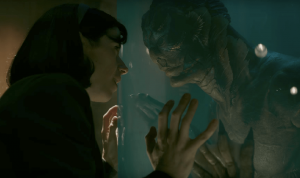
Yes, I am aware that this is a review of a movie that is over a month old. Yes, I am aware that I have missed the zeitgeist of this movie by many weeks. And yes, I am aware that the initial hype that built through the limited release schedule over the course of December has long passed, having culminated in a wide theatrical release in early January. However, I was unable to see the film until recently and, considering how long it has been since it came out, I’ve decided to forgo a regular review in favor of a conversation about the craft of this movie and the commentaries it provides through its set design and character choices.
The Shape of Water, Guillermo Del Toro’s newest film, is nothing short of a modern monster masterpiece. A spiritual sequel to Creature from the Black Lagoon, the film that directly inspired it, the movie takes all the tropes of a classic monster film and filters them for a modern audience. However, this is not a monster movie at heart. There is nothing horrific about this film, save for the small wounds that powerful humans inflict upon those who lack that power. There is no dark reflection of our fears contained within the monster. There is no cautionary tale about the dangers of science or nuclear war. There are only lonely people, trying to find comfort in a world that hates them for the things it perceives they lack. But perhaps that is the horror of the film.
Regardless, there is a theme to the film that is found in these thoughts: the theme of completion. The protagonist, Elisa, feels incomplete; she has been told all her life that because she cannot speak, there is something wrong with her. Her neighbor, and one of her only two friends, Giles, desires love but cannot have it – no man will give it to him in an age of repression. They both require companionship, and while they have each other, it is an incomplete match. They are two halves of a whole but, as the set design reflects, there is always a wall between them.
The Shape of Water also works within its setting to create a world that asks us to examine our fascination with the idealized time that was the ‘50s. Creature from the Black Lagoon came out in 1954, and the aesthetic of this film is a direct commentary on the setting of the original as well as the constructed version of the 50s we have bought into ever since. Our villain, Colonel Strickland, played by Michael Shannon, lives in a perfect 50s home with a perfect 50s wife and two perfect 50s children. It even has the pop art clock that looks like the sun exploding and bright, garish orange walls. He is representative of all the horrible things that mid-20th century (and present day) American cinema has swept under the rug – sexual harassment, toxic masculinity, racism, ableism, sexism, etc. The film does not shy away from the harsh realities of the past but also does not revel in them.
We focus instead on the characters who would have been marginalized and trivialized in Creature from the Black Lagoon instead of the traditional sci-fi “hero” embodied by Strickland. Yes, Strickland is more villainous than traditional Hollywood monster movie heroes, but he reflects the worst aspects of those “heroes.” He is also couched in the “best” of the ‘50s, juxtaposing that which the American consciousness has deemed as “a simpler, better time” with the horrors those pastels mask.
In contrast to Strickland’s “beautiful past” aesthetic, the rest of the film is steeped in dark, art deco architecture and design. Yet, these are the moments and locations that provide the most warmth and humanity. In the dark corners and hidden locations, we find ourselves. We find our humanity; we find out where we stand. These locations are, however, still dirty, still imperfect. And there is no better example of this reflection than in Giles’ obsession with old Hollywood musicals. He needs them to bring meaning to his life, to bring companionship and to distract him from the world he lives in. He cannot handle the reality of the civil rights rallies, preferring to live in a world that is blissfully unaware of the socials ostracization he faces as a gay man. He wants to live within the perfect fabrication he creates with each Jell-O ad he draws. He is a fallible character, willfully complicit in a system that marginalizes others as well as himself because he does not want to see the harshness of the world. He wants, much like we often do, to see the world as an old Hollywood musical: “perfect,” simple, uncomplicated, and filled with problems that have simple solutions.
At its core, The Shape of Water is a romantic drama that just so happens to feature an amphibious man as the love interest. It is a beautifully constructed movie, unapologetic in its inspirations and one of the most fulfilling films I have seen in a long time. If you can, see this film in theaters. It has much to love and much love to give.
